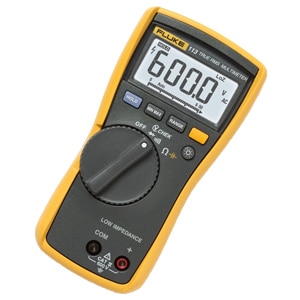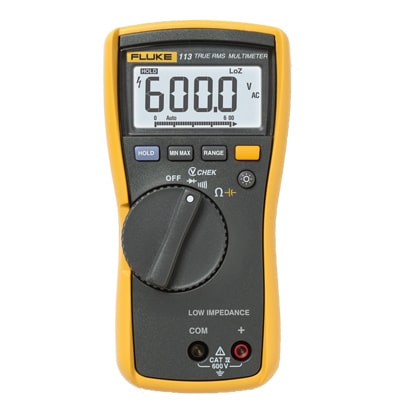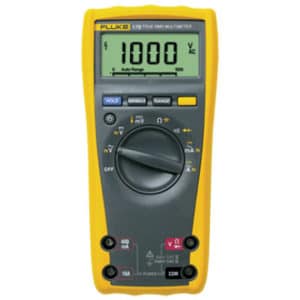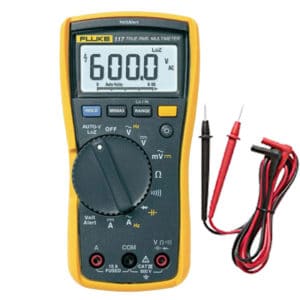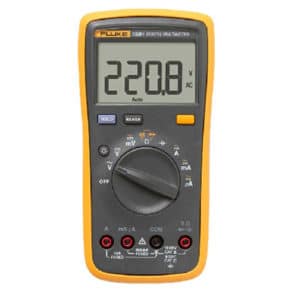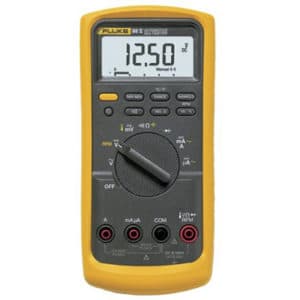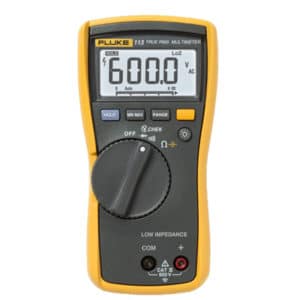Fluke 113 Review
Editor Rating: 4.3/5
Great
Fluke 113
Reviewed by: Tyler Saunders
Published on: May 23, 2018
Last modified: June 28, 2021
- Design
- Functionality
- Price
Fluke 113 Review Summary:
Fluke 113 does not feature professional-level features of the flagship multimeters. However, this handy little device certainly deserves attention, as it looks and works just as advertised.
This DMM is one of the market’s best user-friendly models since it has just a couple of basic ranges that make it suitable for amateurs and trainees. It’s capable of measuring things like capacitance, continuity, resistance, as well as AC/DC voltage. It’s a pretty good choice for those who have to deal with general electrical work, like the HVAC systems, security systems, commercial wiring, etc. Take a look at how it fared on our test:
The Basics
Just like all other multimeters of the Fluke’s 110 Series, this one also comes in the signature black & yellow color combination. It has a sturdy construction that easily withstands abuse, as well as a large, easy-to-operate selection knob and just a couple of additional buttons above it.
It can perform all the basic measurements and brings decent accuracy no matter the task. It is rated CAT-III at 600V and powered by a single 9V battery (included in the package). Its display isn’t the best one we’ve seen so far, but it serves the purpose.

Fluke 113 Features
The Performance
One of the primary differences between this model and the other DMMs in the 110 Series is that it sports a low impedance VCHEK function. This makes the gadget capable of detecting if it’s checking for continuity or measuring voltage. Once it identifies more than 3 volts, Fluke 113 will measure voltage in DC or AC. One of the most significant benefits of this function is that it eliminates ghosting from the nearby live wires.
Unfortunately, Fluke 113 comes without amperage inputs, with its resistance range being limited at 600Ω to 60kΩ. However, it does sport a simple capacitance range. The unit’s continuity tester is very responsive and latching, and the same can be said for the diode check.
We were quite surprised to see this reasonably-priced DMM bearing the mark of a True RMS multimeter. As you can already guess, this will allow you to measure AC variable drive system outputs with a high amount of accuracy. There’s also the much-wanted min/max feature that comes in very handy when it’s hard to decipher a fluctuating signal.
The Protection
As we already said, this model is rated to CAT-III at 600V. It stands up to errant spikes and can effortlessly handle voltage to 6kV, which is quite impressive when we consider that it was made in China to keep down the costs.
The Design
Design-wise, the Fluke 113 boasts a sturdy construction, even though it’s the entry level to the manufacturer’s 110 Series. While made in China, the model features things like a separate battery compartment, integral holster, as well as the durable plastic housing.
Just like on all other Fluke DMMs, the dial selector of 113 is raised, having just three positions and being incredibly easy to operate with thumb only. The buttons are as simple as it gets – backlight, select, hold, min/max, and range (allows you to select between manual and automatic ranging). Beneath the dial are the two inputs, and above it is the display.
The Display
The display featured on Fluke 113 is a 6000-count 3 5/6 digits screen with a bar graph. Both the central part of the screen and the bar graph are very quick when it comes to info update, while the backlight stays on for 40 seconds.
It’s a pretty good screen overall, but with one major downside – it looks a bit darker and washed out, which leads to the loss of clarity when looked upon from an angle. This is a common problem with most of Fluke’s measuring devices, and one we hope to see fixed in the upcoming years.
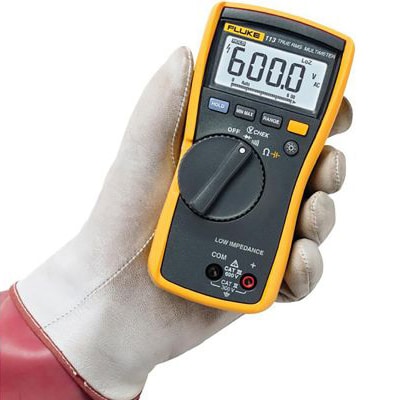
Who Can Use The Fluke 113 Multimeter?
As we already said, the user-friendliness of this model makes it a perfect solution for the trainees and electronics hobbyists. However, the fact that Fluke 113 is a True RMS multimeter that provides a high amount of accuracy makes it quite suitable for the commercial electricians, such as the HVAC technicians.
Fluke 113 Pros:
Solid construction
User-friendly interface
A True RMS model
Auto voltage / continuity detection
Reasonable price
Cons:
Washed out display
Low impedance can load up the circuitry
What We Didn’t Like
Just like some other DMMs manufactured by Fluke, the 113 also features a problematic display. Don’t get us wrong – it works well and shows all the measurements you’ll need – it’s just that it tends to lose its contrast from time to time. This is especially true when you take a look at it from an angle.
Even though the unit’s low impedance brings a benefit of eliminating the ghosting from the nearby wires while you’re troubleshooting, it also introduces a significant downside. This feature is not that good when it comes to testing sensitive electronic equipment since it’s capable of loading up the circuitry.
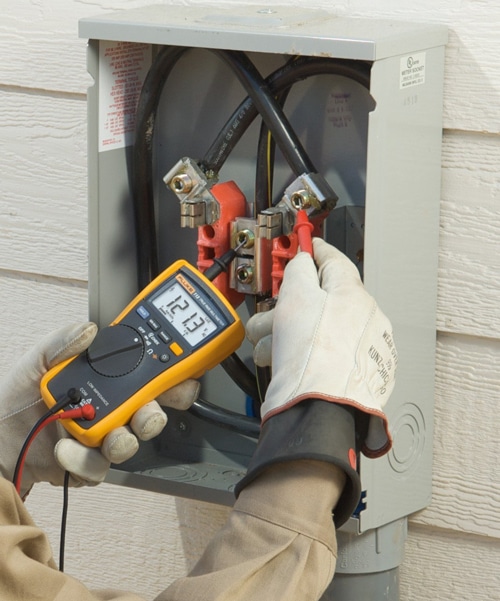
What Users Say About The Fluke 113?
The users say that Fluke 113 is a very convenient and user-friendly multimeter. They praise the unit’s simple interface, claiming that just a couple of buttons on the model’s facade makes it very easy to figure out how everything works.
Another thing that the users are pleased with is the unit’s accuracy. It’s a True RMS gadget, and it, therefore, allows even the biggest electronics amateurs to make the most precise measurements. However, the users are most pleased with the model’s price – some of them still can’t believe how many features this gadget packs at such a low price.
Conclusion
In conclusion, we can safely say that we’re seriously impressed with the model’s value for the money. Even though it sports a reasonable price, the Fluke 113 is still an accurate, True RMS meter with an excellent build quality and user-friendly controls.
It is, therefore, suitable for both the beginners and electronics technicians – both of these groups will find the gadget to be of great assistance. Those who need a more elaborate tool should look elsewhere – Fluke 117 is a good option.
